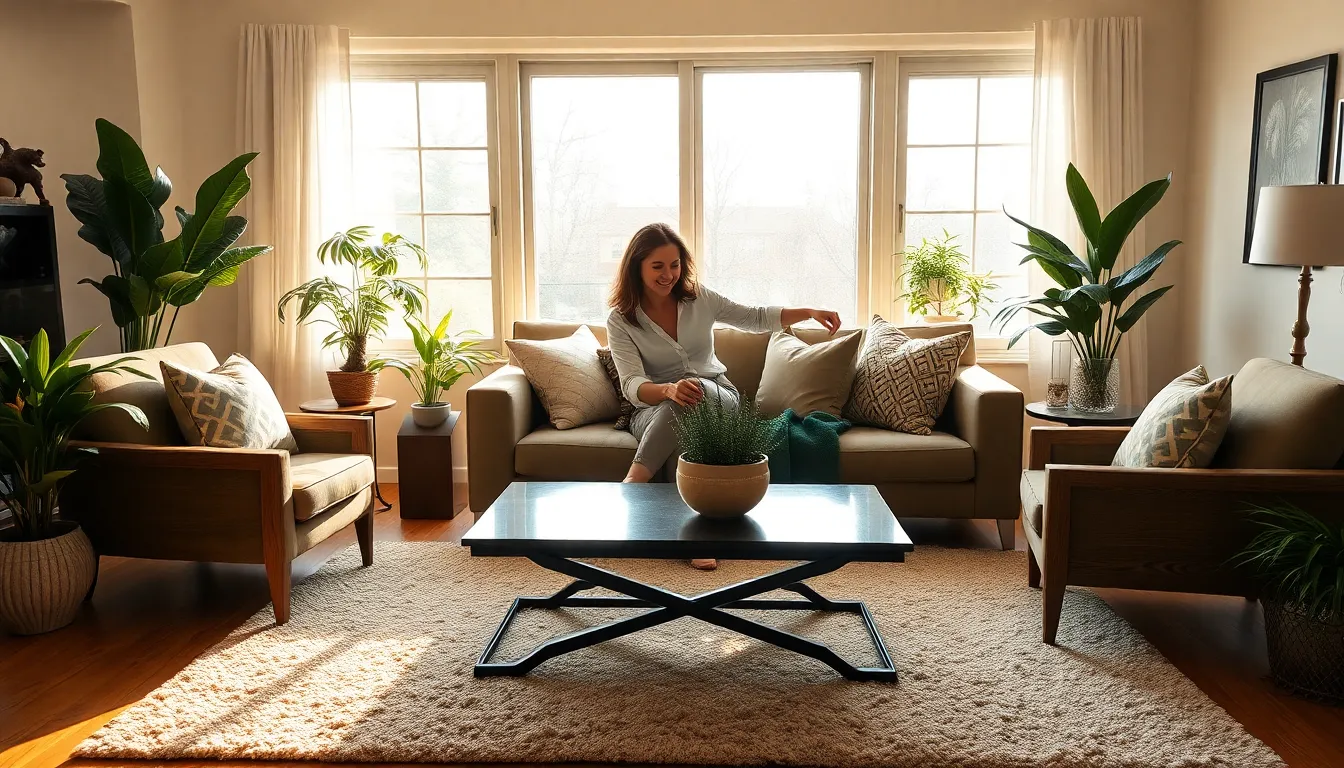Table of Contents
ToggleImagine walking into a room where every piece of furniture seems to have a purpose, a story, and a perfect spot. Mindful furniture placement isn’t just about avoiding that awkward sofa stare-down; it’s about creating harmony and flow in your living space. When furniture is arranged with intention, it transforms a mere room into a sanctuary of comfort and style.
Picture this: a couch that invites conversation, a chair that beckons you to relax, and a table that’s not just for holding snacks but also for sparking creativity. By being mindful of how furniture interacts with each other and the space around them, anyone can elevate their home from “meh” to “wow.” So let’s dive into the art of mindful furniture placement and discover how to make every inch of your space work for you—without turning your living room into a game of Tetris.
Understanding Mindful Furniture Placement
Mindful furniture placement involves intentional arrangement of furniture to foster a harmonious atmosphere. This concept enhances both aesthetics and functionality within living spaces.
Definition and Importance
Mindful furniture placement refers to the strategic arrangement of furniture to create a balanced and purposeful environment. It holds significant importance as it influences how individuals interact with their surroundings. Careful consideration of furniture placement promotes energy flow and visual appeal. Each piece serves a specific purpose, contributing to the overall comfort of the space. This practice enhances user experience, making homes more inviting and functional.
Benefits for Living Spaces
Mindful furniture placement offers numerous benefits for living spaces. First, it maximizes room functionality by optimizing space and ensuring accessibility. Second, it creates visual harmony, leading to a more aesthetically pleasing environment. Third, intentional arrangements encourage conversation and social interactions among residents and guests. Additionally, this practice reduces clutter and enhances organization, fostering a sense of calm. Ultimately, these benefits promote well-being, making the living space a true sanctuary.
Key Principles of Mindful Furniture Placement
Mindful furniture placement emphasizes intentional arrangements that enhance both usability and visual appeal in a living space.
Functionality and Flow
Prioritizing functionality is crucial for optimizing room usage. Each piece of furniture should serve a clear purpose, facilitating movement and interaction. Arranging items in a way that minimizes obstacles allows for smoother navigation. It’s essential to consider the room layout, ensuring pathways remain accessible and inviting. For example, placing chairs around a coffee table encourages conversation while maintaining a functional space. Organizing furniture to align with activities fosters a logical flow, making everyday tasks easier to manage.
Aesthetics and Harmony
Creating visual harmony involves balancing various design elements. Each piece of furniture should complement the others, contributing to a cohesive look. Using similar colors or materials unifies individual items, establishing a tranquil environment. Incorporating varying heights and textures adds depth to the design, enhancing overall aesthetic appeal. Arranging furniture around focal points, such as a fireplace or artwork, draws attention and creates an inviting atmosphere. Layering decor elements thoughtfully can also increase visual interest while maintaining harmony in the space.
Techniques for Mindful Furniture Placement
Mindful furniture placement involves specific techniques that enhance the overall vibe of a space. These methods cultivate an inviting and functional environment.
Zoning Your Space
Zoning your space creates distinct areas tailored for various activities. Furniture arrangement can segment a room, establishing comfortable zones for relaxing, working, or entertaining. Positioning sofas and chairs in a way that encourages conversation fosters sociability. Additionally, using rugs can help define these zones, adding warmth and comfort. Ensure that walkways remain clear, promoting fluid movement throughout the area. Assess the purpose of each zone when selecting furniture to achieve a harmonious balance.
Creating Focal Points
Creating focal points draws attention and sets the tone for the room. A statement piece, such as a striking artwork or a bold sofa, serves as an anchor for surrounding furniture. Positioning this piece strategically can guide furniture arrangement, enhancing cohesion. Lighting elements can also act as focal points, elevating ambiance and interest. Incorporating textures and colors around these focal points harmonizes the space, adding depth. Prioritize visual interest while maintaining a clean layout to keep the area inviting and organized.
Common Mistakes to Avoid
Mindful furniture placement involves avoiding specific pitfalls that disrupt a room’s harmony and functionality. Recognizing and addressing these mistakes can enhance the overall environment.
Overcrowding and Clutter
Overcrowding occurs when too much furniture or décor fills a space. This compression stifles movement, making it hard for individuals to navigate comfortably. Cluttered surfaces add to this chaos, detracting from the room’s appeal. Well-placed furniture allows for breathing room, promoting a more open and inviting atmosphere. Prioritize purposeful pieces that complement each other. Less truly is more when creating an organized and serene setting.
Ignoring Traffic Patterns
Ignoring traffic patterns disrupts natural movement within a space. Effective furniture placement considers how individuals flow through a room. Blocked pathways create frustration and limit engagement in communal areas. Open traffic patterns lead to improved interaction and relaxation. Ensure walkways are unobstructed to guide movement seamlessly between zones. Smart arrangement fosters an inviting environment, enhancing the overall experience for everyone.
Mindful furniture placement is more than just an aesthetic choice; it’s a pathway to creating a nurturing environment. By thoughtfully arranging furniture, individuals can enhance functionality and promote a sense of well-being in their living spaces. Each piece contributes to the overall balance and flow, allowing for seamless interactions and a welcoming atmosphere.
Taking the time to assess how furniture interacts with the space can lead to a more organized and inviting home. Embracing the principles of mindful placement empowers individuals to transform their surroundings into true sanctuaries, fostering comfort and connection. With intentionality and creativity, anyone can elevate their space and enrich their daily experiences.







